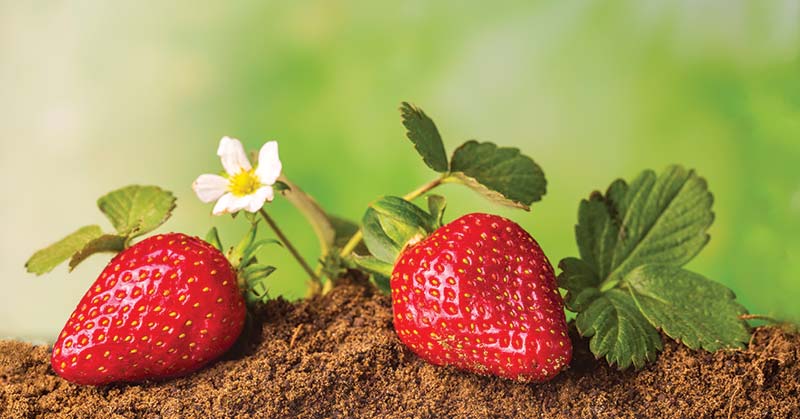Strawberries are not only delicious but also surprisingly easy to grow, making them a fantastic choice for both experienced gardeners and beginners.
This blog post will guide you through the steps to start your own strawberry patch, from selecting the right variety to enjoying the fruits of your labor.
Step 1: Choosing the Right Strawberry Variety
Before planting, decide which type of strawberry you want to grow. The three main types are:
- June-bearing strawberries produce a large, concentrated crop in late spring or early summer.
- Ever-bearing strawberries yield smaller amounts of fruit from late spring through fall.
- Day-neutral strawberries produce fruit consistently throughout the growing season, regardless of day length.
Consider your climate and how you plan to use the strawberries when choosing a variety. Some are better for eating fresh, others are ideal for preserves or freezing.
Step 2: Selecting and Preparing the Planting Site
Strawberries thrive in sunny, well-drained locations. A spot that receives at least six to eight hours of sunlight per day is ideal. Prepare the soil by removing weeds and loosening it to a depth of about 6-8 inches.
Strawberries prefer slightly acidic soil (pH between 5.5 and 6.8). You can amend the soil with compost to improve fertility and drainage.
Step 3: Planting
The best time to plant strawberries is in early spring. When planting:
- Set the strawberry plants so that the roots are well covered in soil but the crown is just above the surface.
- Space plants about 18 inches apart in rows that are 3-4 feet apart.
- After planting, water the strawberries thoroughly.
Step 4: Watering and Mulching
Strawberries need regular watering, especially when the plants are establishing and during fruit production. Aim for about one inch of water per week. Mulching with straw or pine needles helps retain moisture, control weeds, and prevent soil-borne diseases.
Step 5: Fertilizing
Feed your strawberries with a balanced fertilizer when you plant them and again in midsummer. Avoid high-nitrogen fertilizers as they can promote leaf growth at the expense of fruit production.
Step 6: Managing Pests and Diseases
Keep an eye out for common pests like slugs, snails, and birds. You can use netting to protect the fruit from birds. Rotating your strawberry patch every three to four years can help prevent disease buildup.
Step 7: Harvesting
Strawberries are ready to harvest when they are fully red. Pick them in the morning when they are still cool for the best flavor. Regular picking encourages more fruit production.
Conclusion
Growing strawberries can be a rewarding experience, offering the joy of fresh, home-grown fruit right from your garden. With these tips, you’re well on your way to enjoying sweet and juicy strawberries.
FAQs on How do you Start Growing Strawberries
Q: What is the best time of year to plant strawberries?
A: The ideal time to plant strawberries is early spring, once the risk of frost has passed. In warmer climates, strawberries can also be planted in the fall.
Q: How much sunlight do strawberry plants need?
A: Strawberry plants require full sunlight, which means at least 6-8 hours of direct sunlight per day.
Q: What type of soil is best for growing strawberries?
A: Strawberries grow best in well-drained, loamy soil with a slightly acidic pH, typically between 5.5 and 6.8. Enriching the soil with organic matter like compost can be beneficial.
Q: How should I space my strawberry plants?
A: Plant strawberries about 18 inches apart in rows that are spaced 3-4 feet apart. This spacing allows for adequate air circulation and room for growth.
Q: Do strawberries need a lot of water?
A: Yes, regular watering is important, especially when the plants are young and during fruit production. Aim for about an inch of water per week, but avoid over-watering as strawberries do not like soggy soil.
Q: What are the differences between June-bearing, ever-bearing, and day-neutral strawberries?
A: June-bearing strawberries produce a large crop in late spring or early summer, ever-bearing strawberries yield fruit twice a year (in late spring and late summer), and day-neutral strawberries produce fruit consistently throughout the growing season.
Q: How do I protect strawberry plants from pests and birds?
A: Use netting to protect strawberries from birds. For slugs and snails, set traps or use organic bait. Keeping the garden clean and free from debris can also help minimize pests.
Q: When is the right time to harvest strawberries?
A: Harvest strawberries when they are fully red and have reached their full flavor. This is typically a few days after they have fully colored. Picking them in the morning when they are cool can enhance their taste.
Q: Can I grow strawberries in containers?
A: Yes, strawberries can be successfully grown in containers, hanging baskets, or strawberry pots. Ensure that the container has good drainage and is big enough to accommodate the root system.
Q: Do I need to fertilize my strawberry plants?
A: Yes, strawberries benefit from fertilization. Use a balanced fertilizer at planting time and again in midsummer. Avoid high-nitrogen fertilizers as they encourage leaf growth over fruit production.




